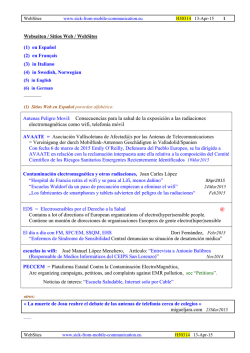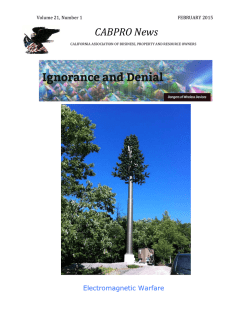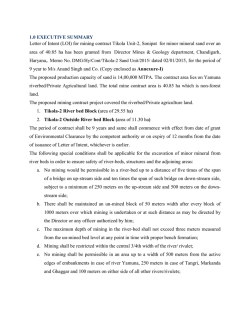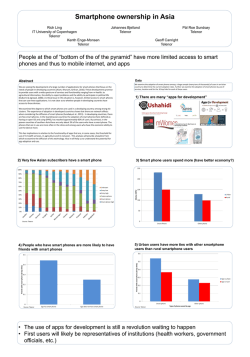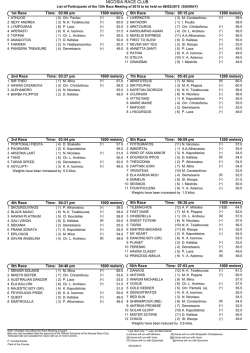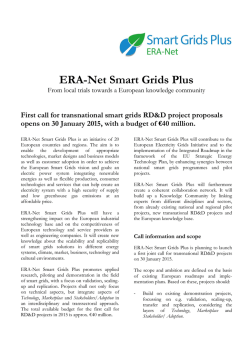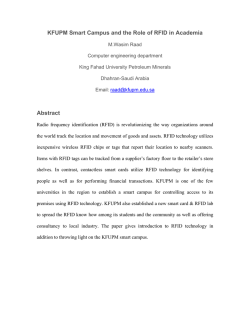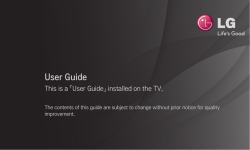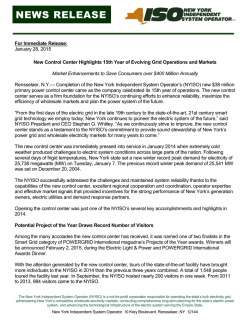
1 EMR Australia PL ABN 82 104 370 658 PO Box 347 Sylvania
EMR Australia PL ABN 82 104 370 658 PO Box 347 Sylvania Southgate NSW 2224 02 9576 1772 [email protected] www.emraustralia.com.au 30 January 2015 Energy Strategy Submissions Department of State Growth GPO Box 536 Hobart TAS 7001 Dear Sir/Madam Tasmanian Energy Strategy Thank you for the opportunity to comment on the above document. The document refers to ‘smart network solutions’ (section 4.3.5) as a desirable direction for the future. ‘A smarter electricity network has the potential to significantly improve operational efficiency’, it says. 1. Radiofrequency electromagnetic fields Although the word ‘smart’, as applied to electricity meters, has positive connotations, it must be remembered that it is merely a euphemism for ‘radiation-emitting’. ‘Smart’ meters emit radiofrequency electromagnetic fields which penetrate walls and expose those living within the buildings to which they are attached. As electricity meters are often attached to bedroom walls, it is not uncommon for people’s heads to be in close proximity, for long periods of time, to the meters’ antennas as they transmit radiofrequency signals. I urge your government to take into consideration that: 1.1 Radiofrequency electromagnetic fields have been classified by the International Agency for Research on Cancer as Class 2B carcinogens.1 1.2 Numerous studies show that low levels of exposure to these fields is associated with adverse biological effects such as changes to neurotransmitters, hormones, cell behaviour, DNA breaks, cancer and brain tumours.2 1 International Agency for Research on Cancer, Monographs on the Evaluation of Carcinogenic Risks to Humans, Volume 80, Non-Ionizing Radiation, Part 1: Static and Extremely Low-Frequency (ELF) 2 McLean, Lyn, ‘The Force’, Melb, Scribe, 2011 1 1.3 Many people report adverse symptom that coincide with the activation of smart meter networks in their neighbourhoods – whether or not they were aware that the meters were active. These symptoms are consistent with those reported in the scientific literature from exposure to radiofrequency radiation. 3 1.4 The Australian radiofrequency standard does not protect the public from harmful effects of radiation from ‘smart’ meters. 4 It has been designed to protect against instantaneous, acute, heating effects and not the continuous, low-level, long-term biological effects that are of concern with ‘smart’ meters. ARPANSA does not claim that compliance with its standard ensures ‘safety’. 1.5 Before any rollout is considered, the Government must ensure that any new electricity meters are proven safe – as opposed to simply complying with the ARPANSA standard 2. Cost issues The draft document states that ‘ultimately intelligent networks and solutions are expected to lower cost.’ 2.1 This has not been the case so far, as consumers have reported elevated electricity costs in the media. 2.2 Even if these networks do ultimately lower costs, it is important to remember that this is less important than public health and safety. 2.3 Litigation and compensation costs need to be considered. (See section 3.) 3. Legal considerations 3.1 If the Government supports or mandates the rollout of ‘smart’ meter technology, it makes itself liable for any meter-related problems that might occur in the future. 3.2 The government and electricity networks may face class action if radiation from ‘smart’ meters causes health-related problems for consumers. I draw to your attention the legal case: McDonald and Comcare, in which Dr McDonald was awarded compensation for injuries received in the workplace by exposure to extremely low levels of radiofrequency radiation. 5 3 Lamech, F, ‘Self-Reporting of Symptom Development From Exposure to Radiofrequency Fields of Wireless Smart Meters in Victoria, Australia: A Case Series’, Altern Ther Health Med 20(6):28-39, 2014. 4 ARPANSA RP3 “Maximum exposure levels to radiofrequency fields – 3 kHz to 300 GHz” Radiation Protection Series 2002. 5 Administrative Appeals Tribunal, February 2013, http://www.austlii.edu.au/au/cases/cth/aat/2013/105.html#sthash.z8p1029b.dpuf 2 4. Other problems of ‘smart’ electricity meters While listing perceived advantages of ‘smart’ meters, the document fails to address problems with the technology that have arisen as a result of the rollout of the technology in other parts of Australia and elsewhere in the world. These include: • strong community backlash • fire risks • ability of utilities to remotely control household electricity • privacy and security of information about household activities. As an example, Canada’s Electrical Safety Authority (ESA) recently announced that approximately 5,400 smart meters are being replaced in Ontario because of fire risk concerns.6 The community cannot and will not have confidence in ‘smart’ meter technology till the problems identified above have been addressed. I trust that the Government will take these comments into consideration and look forward to its response to them. Yours faithfully Lyn McLean Managing Director 6 thestar.com, 26.01.15. 3
© Copyright 2024
